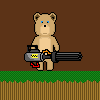I think I was too vague when asking for gap closing, faces, and planar maps. My questions were targeted at the workflow of how to handle several curves together to define a higher level topology. E.g. are overlapping curves (semi-)automatically intersected and joined, usually done by processing them as a planar map, so that the user can paint to areas without the need of explicitly marking the boundaries? (Of course, the curves should still be available as objects in a higher level.)
of
... although I'm still uncertain whether to go on with it or find something more promising to work on
Who can tell ?!
My brother is graphic designer, currently working on a graphic novel. Recently he has tested many 2D tools (PhotoShop, InkScape, Pixelmator, ToonBoom, ArtRage, SketchBook Pro, ...) with this in mind, and none of them is really satisfying his desires. Besides some being too close to the pixel art basis, the workflows are often also not revolutionary, so to say, but too technical.
However, all these tools have a head start compared to your Curver, partly of more than 15 years. They are much more complete considering the overall process of creating graphics. As an independent artist (and that is probably your market) my brother is doing all aspects from drafting to drawing, inking, painting, and texting, and switching tools in-between isn't what he wants to do, if possible.
So, there is probably a market for artist friendly workflows, but catching up on the functionality shown by competitors would be really hard. You need at least provide an easy integration into a bigger workflow.
![]()







